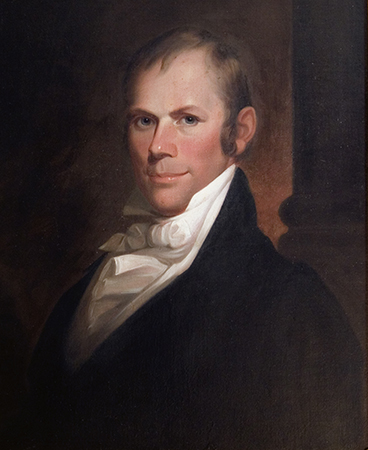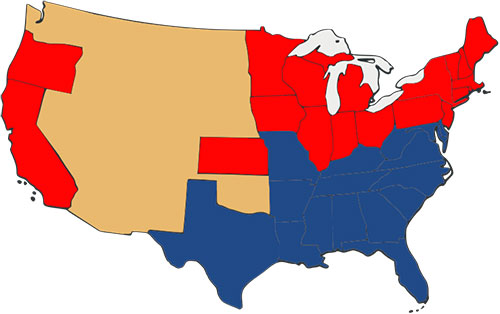Learn
Nationalism versus Sectionalism
After the War of 1812, the United States experienced a wave of nationalism, or devotion to one's own nation. Remember that the period during James Monroe's presidency was known as the Era of Good Feelings in which nationalism peaked and the Monroe Doctrine was issued in 1823. During this period, the Democratic-Republican Party was dominant.
Need a refresher on the Monroe Doctrine?
Review: The Monroe Doctrine stated:
- The United States would stay out of European affairs.
- The Western Hemisphere was closed to colonization from Europe.
- The United States would act as a 'protector' of the region. Any attempt by a European country to oppress or control a nation in the Western Hemisphere would be considered a hostile act against the United States.
The Era of Good Feelings was a sort of lull before the storm. The divisive politics of slavery and feelings of sectionalism were creating a deep divide between the North and South. Sectionalism is a tendency to be more concerned with the interests of your particular region than with the problems of the country. It would have a major impact on the United States throughout the remainder of the 19th century!
The American System
To unify the nation and the growing divide between its economic interests in the North and South, Speaker of the House Henry Clay promoted a plan that became known as the American System in 1816. This plan encouraged Americans to buy and sell American-made products with as little dependence on foreign products as possible.

The American System plan included four major points:
- Establish a protective, high tariff, a duty or tax added to the price of imported goods so that domestic goods are cheaper. This kept American products less expensive and generated revenue for the federal government.
- Develop transportation systems and other internal improvements to help move goods from one region to another. At this point, wagons, boats and barges are the common way to transport goods. The tariff would help pay for improvements to roads and waterways.
- Reestablish the national bank that had significantly weakened since Washington's administration and create one national currency. At this time, states had banks and issued currency, which became very confusing in trade.
- Maintain high prices for public lands sold to common people to increase federal funds. The federal government controlled vast amounts of land they sold to the common people, thus adding more money to the federal coffers.
The American System was a form of economic nationalism, a situation in which a country tries to protect its own economy by reducing the number of imports and investments from other countries.
As Clay explained it, he believed that this plan would allow the industrial North to produce the manufactured goods that farmers in the South and West needed to buy. Meanwhile, the mostly agricultural South and West would produce most of the grain, meat, and cotton needed in the North. With each region of the country supporting each other, America would finally be independent from Europe!
The American System had mixed results. It did help create a national currency and fund internal improvements such as roads, bridges, and canals. For example, the development of the Chesapeake and Ohio Canal improved the transportation of coal, lumber, and agricultural products. Canals are artificial waterways, and this 184.5 mile long C&O Canal ran parallel to the Potomac River and allowed cargo boats to float from Washington, D.C., to Cumberland, Maryland. It was especially important as it connected the coalfields of the Allegheny Mountains to the urban markets at the top of the Chesapeake Bay.
However, the American System also encouraged sectionalism. The North and East welcomed tariffs on imported, foreign goods because the tariffs protected their domestic manufacturing interests. However, the South and West worried that the tariffs would only make goods more expensive for them.
Nationalism and its Impact
At the turn of the 19th century, innovations in transportation and technology such as the steamboat helped to unite the economic lives of the North and the South. This movement of American passengers from one region of the country to the other helped to increase the American national spirit and unify citizens.
Another element that served to increase nationalism was the increase of federal power as the result of two landmark cases in the early 19th century. In 1808, Robert Fulton and Robert Livingston had received a charter from New York giving them the exclusive right to run steamboats on rivers in that state. They would then grant licenses to steamboat operators.
One of these steamboat operators, Aaron Ogden, was running his steamboat between New York and New Jersey, a neighboring state, and believed he was the only one licensed to do so. Another operator, Thomas Gibbons, also believed he was the only operator licensed to transport passengers from New York to New Jersey. Ogden took Gibbons to court to stop him, but since more than one state was involved, in 1824, the Supreme Court ruled that only the federal government could regulate interstate commerce, or business involving more than one state. This decision, Gibbons v. Ogden, showed that the federal government had the power to regulate anything that crosses state lines which continues to have an impact on America today.
Another major decision was McCulloch v. Maryland in 1824. In this case, the state of Maryland had passed a heavy tax on the local branch of the Bank of the United States, hoping to make it fail. However, Chief Justice John Marshall ruled against Maryland, declaring if the tax was allowed, states could overturn federal laws. Not only did this decision strengthen the federal government's power over the economy, it also firmly established that the federal government was the supreme law of the land.
Nationalism had an impact on foreign policy as well. Under President James Monroe, his Secretary of State John Quincy Adams worked out a treaty in 1817 with Great Britain to reduce the number of ships in the Great Lakes. This treaty, the Rush-Bagot Treaty, led the United States and Canada to eliminate any military presence at the border. Spanish Florida was still an issue, and many Americans worried about a foreign presence on American soil. This problem was solved by the Adams-Onis Treaty in 1819 in which Spain gave Florida to the United States and gave up its claims to the Oregon Territory. These events not only strengthened American nationalism, but also reinforced the principles of the Monroe Doctrine and showed the world that America was becoming a global power.
Sectionalism threatens National Unity
A lingering issue threatened the national spirit and unity that the "Era of Good Feelings" had promoted. That issue was slavery. As more settlers had moved into the Northwest Territory, plans to apply for statehood followed. However, when settlers in the Missouri Territory applied for statehood in 1819, conflict arose. Since most Americans expected there to be a balance of free and slave states, adding Missouri would upset the balance.
Since Illinois was added as a free state in 1818 and Alabama had been admitted as a slave state in 1819, there were eleven free and eleven slave states. The slaveholding states claimed that the North was trying to end slavery and the Northern states believed that the South was trying to extend slavery into new territories.

Under the leadership of Henry Clay, Congress created a temporary solution with a set of agreements known as the Missouri Compromise (1820). Maine would be admitted as a free state and Missouri would be admitted as a slave state, keeping the balance of free and slave states intact.
The rest of the Louisiana Territory was split into two halves divided at the 36°30' north parallel - one half for slaveholders and the other for free settlers. South of the line, slavery was legal; north of the line (except in Missouri), it was not. President Monroe signed the Missouri Compromise in 1820 and at least temporarily, the issue of slavery was settled. Read The Missouri Compromise to learn more.
| Slave States | Free States |
|---|---|
| Alabama | Connecticut |
| Delaware | Illinois |
| Florida | Indiana |
| Georgia | Maine |
| Kentucky | Massachusetts |
| Louisiana | Michigan |
| Maryland | New Hampshire |
| Mississippi | New Jersey |
| Missouri | New York |
| North Carolina | Ohio |
| South Carolina | Pennsylvania |
| Tennessee | Rhode Island |
| Virginia | Vermont |